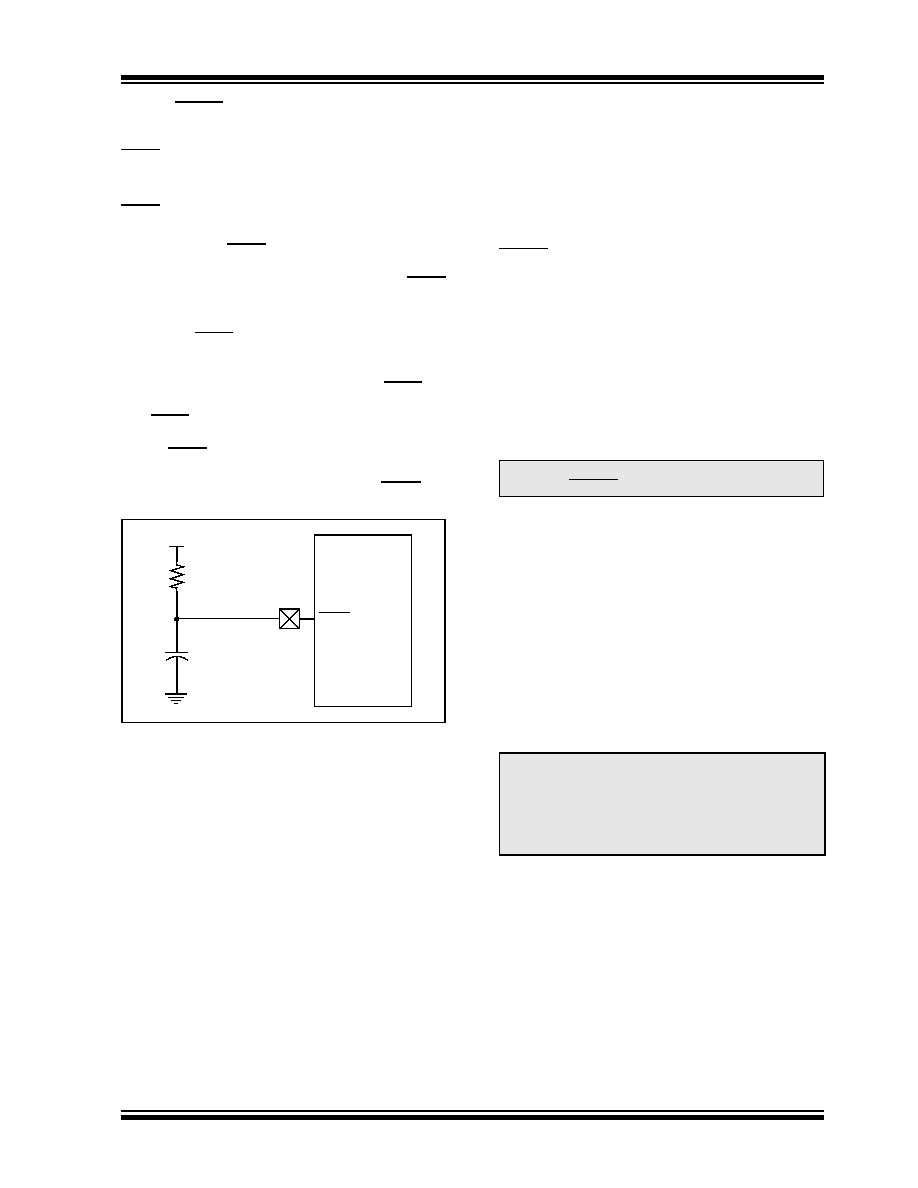- 您現(xiàn)在的位置:買(mǎi)賣(mài)IC網(wǎng) > PDF目錄20620 > AC244026 (Microchip Technology)EXTENSION PAK PIC16F727-ICE PDF資料下載
參數(shù)資料
| 型號(hào): | AC244026 |
| 廠商: | Microchip Technology |
| 文件頁(yè)數(shù): | 204/274頁(yè) |
| 文件大小: | 0K |
| 描述: | EXTENSION PAK PIC16F727-ICE |
| 標(biāo)準(zhǔn)包裝: | 1 |
| 類(lèi)型: | 調(diào)試程序 |
| 適用于相關(guān)產(chǎn)品: | PIC16F727 |
| 所含物品: | 2 個(gè)板 |
第1頁(yè)第2頁(yè)第3頁(yè)第4頁(yè)第5頁(yè)第6頁(yè)第7頁(yè)第8頁(yè)第9頁(yè)第10頁(yè)第11頁(yè)第12頁(yè)第13頁(yè)第14頁(yè)第15頁(yè)第16頁(yè)第17頁(yè)第18頁(yè)第19頁(yè)第20頁(yè)第21頁(yè)第22頁(yè)第23頁(yè)第24頁(yè)第25頁(yè)第26頁(yè)第27頁(yè)第28頁(yè)第29頁(yè)第30頁(yè)第31頁(yè)第32頁(yè)第33頁(yè)第34頁(yè)第35頁(yè)第36頁(yè)第37頁(yè)第38頁(yè)第39頁(yè)第40頁(yè)第41頁(yè)第42頁(yè)第43頁(yè)第44頁(yè)第45頁(yè)第46頁(yè)第47頁(yè)第48頁(yè)第49頁(yè)第50頁(yè)第51頁(yè)第52頁(yè)第53頁(yè)第54頁(yè)第55頁(yè)第56頁(yè)第57頁(yè)第58頁(yè)第59頁(yè)第60頁(yè)第61頁(yè)第62頁(yè)第63頁(yè)第64頁(yè)第65頁(yè)第66頁(yè)第67頁(yè)第68頁(yè)第69頁(yè)第70頁(yè)第71頁(yè)第72頁(yè)第73頁(yè)第74頁(yè)第75頁(yè)第76頁(yè)第77頁(yè)第78頁(yè)第79頁(yè)第80頁(yè)第81頁(yè)第82頁(yè)第83頁(yè)第84頁(yè)第85頁(yè)第86頁(yè)第87頁(yè)第88頁(yè)第89頁(yè)第90頁(yè)第91頁(yè)第92頁(yè)第93頁(yè)第94頁(yè)第95頁(yè)第96頁(yè)第97頁(yè)第98頁(yè)第99頁(yè)第100頁(yè)第101頁(yè)第102頁(yè)第103頁(yè)第104頁(yè)第105頁(yè)第106頁(yè)第107頁(yè)第108頁(yè)第109頁(yè)第110頁(yè)第111頁(yè)第112頁(yè)第113頁(yè)第114頁(yè)第115頁(yè)第116頁(yè)第117頁(yè)第118頁(yè)第119頁(yè)第120頁(yè)第121頁(yè)第122頁(yè)第123頁(yè)第124頁(yè)第125頁(yè)第126頁(yè)第127頁(yè)第128頁(yè)第129頁(yè)第130頁(yè)第131頁(yè)第132頁(yè)第133頁(yè)第134頁(yè)第135頁(yè)第136頁(yè)第137頁(yè)第138頁(yè)第139頁(yè)第140頁(yè)第141頁(yè)第142頁(yè)第143頁(yè)第144頁(yè)第145頁(yè)第146頁(yè)第147頁(yè)第148頁(yè)第149頁(yè)第150頁(yè)第151頁(yè)第152頁(yè)第153頁(yè)第154頁(yè)第155頁(yè)第156頁(yè)第157頁(yè)第158頁(yè)第159頁(yè)第160頁(yè)第161頁(yè)第162頁(yè)第163頁(yè)第164頁(yè)第165頁(yè)第166頁(yè)第167頁(yè)第168頁(yè)第169頁(yè)第170頁(yè)第171頁(yè)第172頁(yè)第173頁(yè)第174頁(yè)第175頁(yè)第176頁(yè)第177頁(yè)第178頁(yè)第179頁(yè)第180頁(yè)第181頁(yè)第182頁(yè)第183頁(yè)第184頁(yè)第185頁(yè)第186頁(yè)第187頁(yè)第188頁(yè)第189頁(yè)第190頁(yè)第191頁(yè)第192頁(yè)第193頁(yè)第194頁(yè)第195頁(yè)第196頁(yè)第197頁(yè)第198頁(yè)第199頁(yè)第200頁(yè)第201頁(yè)第202頁(yè)第203頁(yè)當(dāng)前第204頁(yè)第205頁(yè)第206頁(yè)第207頁(yè)第208頁(yè)第209頁(yè)第210頁(yè)第211頁(yè)第212頁(yè)第213頁(yè)第214頁(yè)第215頁(yè)第216頁(yè)第217頁(yè)第218頁(yè)第219頁(yè)第220頁(yè)第221頁(yè)第222頁(yè)第223頁(yè)第224頁(yè)第225頁(yè)第226頁(yè)第227頁(yè)第228頁(yè)第229頁(yè)第230頁(yè)第231頁(yè)第232頁(yè)第233頁(yè)第234頁(yè)第235頁(yè)第236頁(yè)第237頁(yè)第238頁(yè)第239頁(yè)第240頁(yè)第241頁(yè)第242頁(yè)第243頁(yè)第244頁(yè)第245頁(yè)第246頁(yè)第247頁(yè)第248頁(yè)第249頁(yè)第250頁(yè)第251頁(yè)第252頁(yè)第253頁(yè)第254頁(yè)第255頁(yè)第256頁(yè)第257頁(yè)第258頁(yè)第259頁(yè)第260頁(yè)第261頁(yè)第262頁(yè)第263頁(yè)第264頁(yè)第265頁(yè)第266頁(yè)第267頁(yè)第268頁(yè)第269頁(yè)第270頁(yè)第271頁(yè)第272頁(yè)第273頁(yè)第274頁(yè)

2009 Microchip Technology Inc.
DS41341E-page 35
PIC16F72X/PIC16LF72X
3.1
MCLR
The PIC16F72X/PIC16LF72X has a noise filter in the
MCLR Reset path. The filter will detect and ignore
small pulses.
It should be noted that a Reset does not drive the
MCLR pin low.
Voltages applied to the pin that exceed its specification
can result in both MCLR Resets and excessive current
beyond the device specification during the ESD event.
For this reason, Microchip recommends that the MCLR
pin no longer be tied directly to VDD. The use of an RC
network, as shown in Figure 3-2, is suggested.
An internal MCLR option is enabled by clearing the
MCLRE bit in the Configuration Word register. When
MCLRE = 0, the Reset signal to the chip is generated
internally. When the MCLRE = 1, the RE3/MCLR pin
becomes an external Reset input. In this mode, the
RE3/MCLR pin has a weak pull-up to VDD. In-Circuit
Serial Programming is not affected by selecting the
internal MCLR option.
FIGURE 3-2:
RECOMMENDED MCLR
CIRCUIT
3.2
Power-on Reset (POR)
The on-chip POR circuit holds the chip in Reset until VDD
has reached a high enough level for proper operation. A
maximum
rise
time
for
VDD
is
required.
See
Section 23.0 “Electrical Specifications” for details. If
the BOR is enabled, the maximum rise time specification
does not apply. The BOR circuitry will keep the device in
When the device starts normal operation (exits the
Reset condition), device operating parameters (i.e.,
voltage, frequency, temperature, etc.) must be met to
ensure operation. If these conditions are not met, the
device must be held in Reset until the operating
conditions are met.
For additional information, refer to Application Note
AN607, “Power-up Trouble Shooting” (DS00607).
3.3
Power-up Timer (PWRT)
The Power-up Timer provides a fixed 64 ms (nominal)
time-out on power-up only, from POR or Brown-out
Reset. The Power-up Timer operates from the WDT
oscillator. For more information, see Section 7.3
“Internal Clock Modes”. The chip is kept in Reset as
long as PWRT is active. The PWRT delay allows the
VDD to rise to an acceptable level. A Configuration bit,
PWRTE, can disable (if set) or enable (if cleared or pro-
grammed) the Power-up Timer. The Power-up Timer
should be enabled when Brown-out Reset is enabled,
although it is not required.
The Power-up Timer delay will vary from chip-to-chip
and vary due to:
VDD variation
Temperature variation
Process variation
See
DC
parameters
for
details
3.4
Watchdog Timer (WDT)
The WDT has the following features:
Shares an 8-bit prescaler with Timer0
Time-out period is from 17 ms to 2.2 seconds,
nominal
Enabled by a Configuration bit
WDT is cleared under certain conditions described in
3.4.1
WDT OSCILLATOR
The WDT derives its time base from 31 kHz internal
oscillator.
VDD
PIC MCU
MCLR
R1
10 k
Ω
C1
0.1
μF
Note:
The Power-up Timer is enabled by the
PWRTE bit in the Configuration Word.
Note:
When the Oscillator Start-up Timer (OST)
is invoked, the WDT is held in Reset,
because the WDT Ripple Counter is used
by the OST to perform the oscillator delay
count. When the OST count has expired,
the WDT will begin counting (if enabled).
相關(guān)PDF資料 |
PDF描述 |
|---|---|
| ISL6610IBZ-T | IC MOSFET DRVR DUAL SYNC 14-SOIC |
| C1005C0G1H080C | CAP CER 8PF 50V NP0 0402 |
| F931V475MCC | CAP TANT 4.7UF 35V 20% 2312 |
| ADE7759ARS | IC ENERGY METERING 1PHASE 20SSOP |
| GBM25DSUI | CONN EDGECARD 50POS DIP .156 SLD |
相關(guān)代理商/技術(shù)參數(shù) |
參數(shù)描述 |
|---|---|
| AC244027 | 功能描述:插座和適配器 Processor Ext Pak (PIC16LF727-ICE)200K RoHS:否 制造商:Silicon Labs 產(chǎn)品:Adapter 用于:EM35x |
| AC244028 | 功能描述:插座和適配器 Processor Ext Pak for PIC24F16KA102 RoHS:否 制造商:Silicon Labs 產(chǎn)品:Adapter 用于:EM35x |
| AC244033 | 功能描述:開(kāi)發(fā)板和工具包 - PIC / DSPIC PIC18F14K22-ICE Processor Ext Pak RoHS:否 制造商:Microchip Technology 產(chǎn)品:Starter Kits 工具用于評(píng)估:chipKIT 核心:Uno32 接口類(lèi)型: 工作電源電壓: |
| AC244034 | 功能描述:開(kāi)發(fā)板和工具包 - PIC / DSPIC PIC18LF14K22-ICE Processor Ext Pak RoHS:否 制造商:Microchip Technology 產(chǎn)品:Starter Kits 工具用于評(píng)估:chipKIT 核心:Uno32 接口類(lèi)型: 工作電源電壓: |
| AC244035 | 功能描述:開(kāi)發(fā)板和工具包 - PIC / DSPIC Processor Ext Pak for PIC16F1939 RoHS:否 制造商:Microchip Technology 產(chǎn)品:Starter Kits 工具用于評(píng)估:chipKIT 核心:Uno32 接口類(lèi)型: 工作電源電壓: |
發(fā)布緊急采購(gòu),3分鐘左右您將得到回復(fù)。